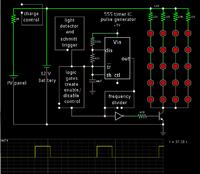LiteBrite
Newbie level 3

I would like to build a circuit to light a physical bridge built over a small stream in my back yard.
I need two strings of 20 LEDs each, to line the sides of the bridge so that people don't fall off in the dark.
I want it to be battery powered, and I want it to turn on 4 hours a night, and then shut off. Light detectors won't work in this location.
The LEDs don't need to be very bright.
It would be better if I didn't need to replace the battery every week.
Can anyone help me with this ?
I need two strings of 20 LEDs each, to line the sides of the bridge so that people don't fall off in the dark.
I want it to be battery powered, and I want it to turn on 4 hours a night, and then shut off. Light detectors won't work in this location.
The LEDs don't need to be very bright.
It would be better if I didn't need to replace the battery every week.
Can anyone help me with this ?


